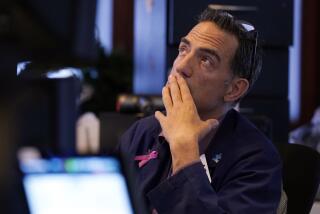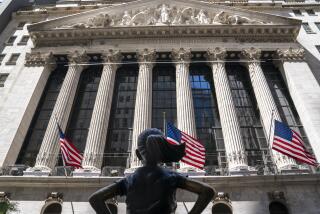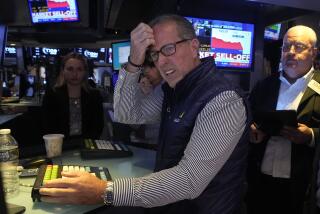A Lot of Caution These Days Isn’t Unhealthy
- Share via
Investors are forever encouraged to focus on the long term. Wall Street is particularly fond of repeating that advice when the short term doesn’t look so hot.
The U.S. stock market has run out of steam this year; most investors know that, or will when they review their quarterly portfolio statements.
Of course, the 2.5% drop in the blue-chip Standard & Poor’s 500 index since Jan. 1 isn’t much of a hit. But it adds to the feeling that financial markets, and the economy, are in a transition phase.
There’s no way to sugarcoat the reality that investors are losing some long-playing trends that have propped up stocks, bonds and housing values in recent years.
Ultra-low interest rates, which lasted from early 2002 through mid-2004, are history now, as the Federal Reserve tightens credit.
The dramatic rebound in corporate profits, which saw S&P; 500 company earnings rise at a 15%-plus year-over-year pace for six quarters through the end of last year, is waning. Profit growth in the first quarter ended March 31 is expected to be about 8%, based on analyst estimates compiled by data tracker Thomson First Call.
And who can forget the good old days of $20-to-$30-a-barrel oil, the norm from 2000 through last spring. On Friday, the going rate was $53.32 a barrel, and the talk of Wall Street is that $100 oil is well within the realm of possibility in the next few years.
The World Bank, financier to developing nations, warned last week that global economic growth was poised to slow in the next few years from the brisk rebound of 2003-04. And with decelerating growth, issues that were papered over in headier times -- the risks inherent in the gigantic U.S. trade deficit, for example -- are likely to take on greater urgency, World Bank economists said.
Notice, however, that the World Bank is predicting slower growth, not negative growth (i.e., recession). If the bank’s forecast is in the ballpark, the global economy still would be expanding at an annual real rate of 3% or so through 2007. That would actually be better than the 2.7% average annual growth rate of 1991 through 2000.
But a key difference between the last decade and this one is that global growth now is being powered much more by the developing world.
Those economies grew at a 3.2% annual rate from 1991 through 2000, not all that much faster than the 2.6% growth rate of developed countries in that period.
This year, by contrast, developing-world economies are expected to expand at a 5.7% rate, more than double the forecast 2.4% rate for the developed world, the World Bank said.
Most U.S. investors have better things to do than keep track of numbers like those, but on a gut level Americans understand that investment opportunities are blossoming overseas. Egged on by the falling dollar and its favorable effect on foreign stocks and bonds, U.S. investors last year pumped record sums into foreign securities.
The irony isn’t lost on Wall Street: At a time when the U.S. economy is more dependent than ever before on foreign financing of our trade and budget deficits, many Americans are sending their personal capital abroad.
Within our own borders, meanwhile, there is widespread frustration with investment choices.
Short-term interest rates are up from their generational lows, but no one is getting rich off 2.2% yields on money market mutual funds.
Bond yields also have risen, but it feels too early to many market veterans to lock in long-term yields, with the Fed still lifting short-term rates and with inflation fears fanned by oil’s surge.
The residential real estate market may or may not be a bubble, depending on where you live in America. But should people really be doing what they’re increasingly doing -- borrowing via risky adjustable-rate mortgages so that they can buy the biggest homes their real estate agent can find for them?
As for the U.S. stock market, shares may not be overly expensive, but neither are they cheap by most Wall Street pros’ reckoning. The average blue-chip stock is priced at about 17 times this year’s estimated earnings per share.
The popular perception is that U.S. stock prices remain far below their highs of the last bull market, which ended in 2000. That’s an accurate statement for most technology issues, but it isn’t true of the average stock. The New York Stock Exchange composite index, which tracks all common shares listed on the exchange, hit a record high of 7,441.18 on March 4. It has declined a modest 3.5% since then, to 7,181.50 as of Friday.
Market bulls say that’s the good news: In the face of rising interest rates, record oil prices, slowing profit growth and other challenges, the U.S. equity market hasn’t crumbled.
The problem is that investors’ margin for error has been reduced as the supportive trends of the last few years weaken or disappear entirely.
If the economy, and U.S. financial markets, in fact are in a transition phase, the question becomes: A transition to what? A slower but more sustainable economic growth rate that allows interest rates to stay tame and stock prices to move gradually higher?
A sharper-than-anticipated economic slowdown that pulls the rug out from under share prices?
Or perhaps another economic boom that drives inflation and interest rates higher, with mixed consequences for stocks?
A lot of good things might yet happen for U.S. financial markets in this decade.
But Bernie Schaeffer, a veteran market player who heads Schaeffer’s Investment Research in Cincinnati, suggests that many investors need to do a better job in this transition phase of assessing the risks they might face if the optimistic scenarios don’t pan out.
He worries that the relatively low level of volatility in the stock market over the last year has lulled investors into believing that a major decline is highly unlikely.
Schaeffer fears the opposite -- that a market pullback could be “rapid and scary, if one does happen.”
The lesson of the 2000-02 bear stock market was that many people whose portfolios were overly exposed to risk found out that once their nest eggs were severely damaged, recovery was an extremely long road. That’s just the way the math works.
A prudent investor today should be asking the questions that many didn’t ask at the market peak in 2000: If things go bad, how bad could it be for me? How much money could I lose -- and how much can I stand to lose?
Joe Wolf, co-manager of the RS Value stock mutual fund in San Francisco, said that concern overlays all others in the $900-million fund’s stock-picking strategy, which has produced an average annualized return of 29% over the last three years.
“We spend a lot more time focusing on the downside than on the upside” in choosing stocks, Wolf said. As value managers, they naturally try to find companies that are undervalued, he said. But scoring with big winners is less important than avoiding big losers, Wolf said.
The idea of prudence today ought to apply to other investments as well, including bonds and real estate.
In this transition phase for the economy and markets, there simply is no good reason to be taking on a lot of risk, Schaeffer said. “It’s like running in front of a steamroller to pick up nickels and dimes,” he said.
*
Tom Petruno can be reached at [email protected].
More to Read
Inside the business of entertainment
The Wide Shot brings you news, analysis and insights on everything from streaming wars to production — and what it all means for the future.
You may occasionally receive promotional content from the Los Angeles Times.










